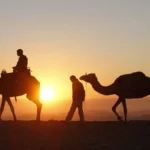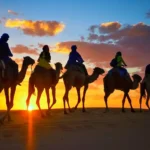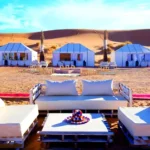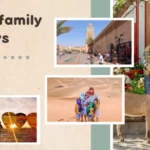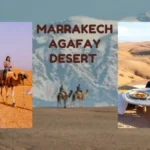Table of Contents
Introduction of Moroccan Fantasia Festival
The thundering of hooves echoes across the dusty plain as a line of mounted warriors charges forward, their ornate rifles raised skyward. The air fills with the acrid scent of gunpowder as dozens of antique firearms discharge in perfect unison, creating a deafening crack that reverberates through your chest. Welcome to the Moroccan Fantasia Festival, a breathtaking spectacle that transforms centuries-old military traditions into one of North Africa‘s most captivating cultural performances.
This ancient art form, known locally as Tbourida Morocco, represents far more than mere entertainment. It’s a living testament to Morocco’s warrior heritage, a celebration of the profound bond between rider and horse, and an unforgettable experience that leaves every witness spellbound. Whether you’re planning your first visit to Morocco or seeking to deepen your understanding of this remarkable kingdom, this comprehensive guide will reveal everything you need to know about experiencing the Moroccan horse festival firsthand.
What is Fantasia? Unpacking the Heart of Moroccan Horsemanship
The Moroccan Fantasia Festival is a traditional equestrian performance that combines skilled horsemanship, ceremonial dress, and synchronized rifle fire to recreate historical cavalry charges. Groups of riders, typically numbering between 15 and 20, gallop in formation across open ground before firing their ornate rifles in perfect unison, a climactic moment that demonstrates both individual skill and collective precision.
Fantasia vs. Tbourida Morocco: While international visitors commonly know this spectacle as “Fantasia”, a term introduced by European observers, the proper Arabic name is “Tbourida.” This linguistic distinction reflects a deeper cultural understanding: “Tbourida” derives from the Arabic word “baroud,” meaning gunpowder, emphasizing the central role of firearms in this traditional art. Using the authentic term demonstrates respect for Moroccan culture and connects you more meaningfully with local traditions.
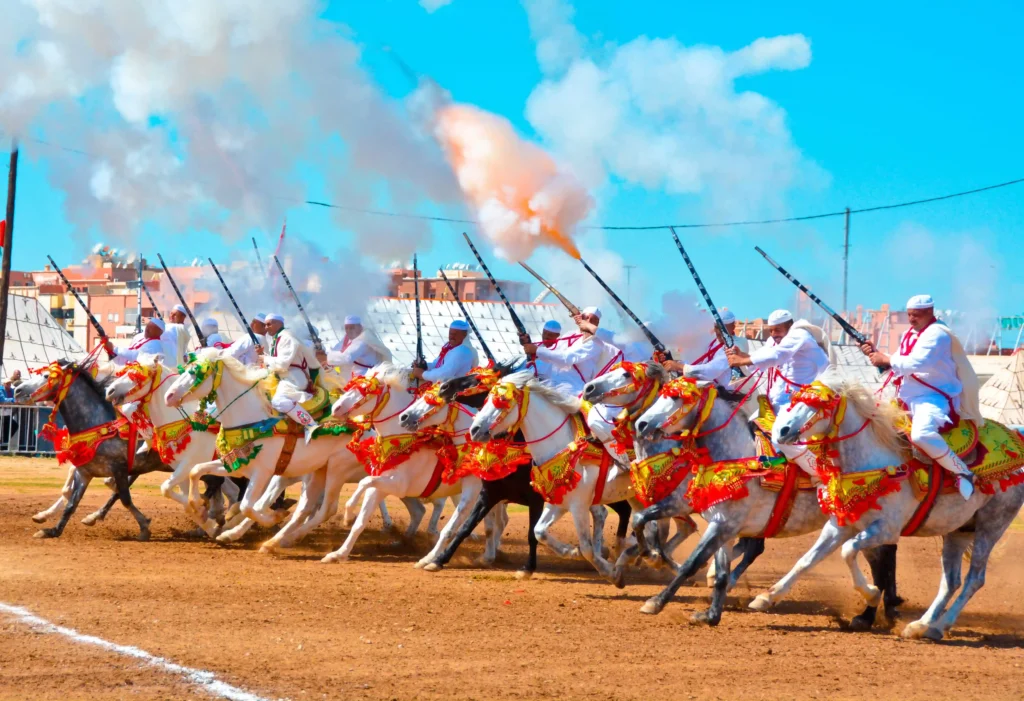
The Soul of a Nation: The Rich History and Symbolism of Tbourida Morocco
Ancient Origins: From Berber Warriors to Ceremonial Art
The roots of Tbourida Morocco stretch back over a millennium, emerging from the practical military tactics of Berber and Arab cavalry units. During the 8th-century Islamic conquest of North Africa and Iberia, Moroccan horsemen developed sophisticated techniques for mounted warfare, including the fearsome cavalry charge that could break enemy lines through sheer psychological impact and tactical precision.
These warriors, known as “faris” (horsemen), perfected the art of firing their weapons while galloping at full speed, a skill requiring extraordinary coordination between rider, horse, and firearm. What began as deadly serious military training gradually evolved into ceremonial displays during peacetime, preserving these ancient techniques for future generations while celebrating Morocco’s martial heritage.
The transformation from battlefield tactic to cultural performance accelerated during the Alaouite dynasty (17th century onwards), when tribal leaders began organizing competitive displays to honor visiting dignitaries and celebrate religious festivals. These events became known as “moussems”, seasonal gatherings that combined spiritual devotion, commercial activity, and cultural celebration.
A Symbol of Status and Honor
In traditional Moroccan society, participation in Tbourida Morocco represented the pinnacle of masculine achievement and social status. The “sorba” (riders) were typically chosen from among the most skilled horsemen in their communities, men who possessed not only exceptional riding abilities but also the financial means to maintain the elaborate costumes, equipment, and trained horses required for the performance.
The horse itself holds sacred significance in Islamic and Berber cultures, viewed as a noble companion blessed by Allah. The Prophet Muhammad famously declared that “the horse is tied to the forelock of good fortune,” and this reverence permeates every aspect of Tbourida. The bond between rider and mount transcends mere utility; it represents a spiritual partnership that embodies honor, courage, and divine blessing.
The Anatomy of the Spectacle: What You’ll See at a Moroccan Fantasia Festival
The Horses: The Revered Berber and Barb Stallions
The stars of any Moroccan horse festival are undoubtedly the magnificent steeds that carry their riders into battle-like charges. Traditional Tbourida exclusively features Berber horses (also known as Barb horses), a breed indigenous to North Africa, renowned for their speed, agility, and intelligence. These compact but powerful animals, standing 14-15 hands high, possess the perfect combination of stamina and explosive acceleration needed for the demanding performances.
Each horse undergoes years of specialized training, learning to gallop in tight formation while remaining calm despite the thunderous gunfire erupting around them. The most accomplished mounts can anticipate their rider’s commands and even the moment of the rifle discharge, positioning themselves perfectly for the dramatic finale.
The horses’ presentation is as important as their performance. Ornate harnesses, crafted from leather and adorned with silver, brass, and vibrant tassels, transform these already beautiful animals into living works of art. Traditional saddles, often family heirlooms passed down through generations, feature intricate metalwork and embroidered fabrics that catch the sunlight as the horses charge across the field.

The Riders: The Sorba and their Traditional Attire
The sorba (riders) present an equally magnificent sight in their traditional ceremonial dress. Each participant wears a flowing white djellaba (hooded robe) cinched with a colorful sash, while their heads are crowned with distinctive turbans that vary in style according to regional traditions. Some groups favor the classic white turban of the Arab traditions, while others opt for the more elaborate headwear associated with specific Berber tribes.
Beneath their robes, riders wear traditional leather boots designed specifically for equestrian activities, and many sport ornate daggers or ceremonial swords that catch the light as they ride. The overall effect creates a powerful visual connection to Morocco’s historical warriors while maintaining the dignity and grace expected in this revered cultural practice.
Within each troupe, specific roles and hierarchies exist. The muqaddam (leader) typically rides at the center of the formation, responsible for timing the charge and signaling the moment for the synchronized rifle fire. Experienced riders mentor newcomers, ensuring that traditional techniques and values are passed on to new generations unchanged.
The Charge: A Symphony of Controlled Chaos
The heart of every Tbourida Morocco performance lies in the charge, a carefully choreographed gallop that appears chaotic to untrained eyes but demonstrates extraordinary skill and coordination. The riders begin at a walk, arranged in a perfectly straight line spanning 100-200 meters. As they advance, the pace gradually increases from trot to canter to full gallop, with each rider maintaining precise spacing and alignment.
The challenge lies not merely in speed but in synchronization. All horses must reach maximum velocity simultaneously, creating a thunderous wall of hoofbeats that builds to a crescendo. The most skilled troupes achieve such perfect timing that their horses’ hooves strike the ground in unison, creating a rhythmic drumbeat that resonates across the performance area.
Spectators often gasp at the apparent recklessness of the charge, but experienced observers recognize the incredible skill required to maintain formation at such speeds. A single horse breaking ranks or stumbling could cause a catastrophic collision, making the successful completion of each charge a testament to years of training and practice.
The Gunpowder Shot: The Climactic ‘Baroud’
The climax of every Moroccan Fantasia Festival performance arrives with the baroud, the simultaneous firing of all rifles that marks the end of the charge. As the horses reach their designated stopping point, riders raise their ornate moukahla (traditional rifles) skyward and fire in perfect unison, creating a thunderous explosion that can be heard for miles.
These antique firearms, often dating back centuries, are works of art in their own right. Crafted by master gunsmiths, they feature intricate silver inlays, carved wooden stocks, and ornate metalwork that reflects the owner’s wealth and status. Many moukahla have been passed down through families for generations, carrying with them the spirits and memories of previous warriors.
The goal is not accuracy but synchronization; a perfectly timed volley demonstrates the troupe’s discipline and skill. Judges and spectators evaluate performances based on the precision of this moment, with the most accomplished groups producing a single, unified explosion rather than a scattered series of individual shots.
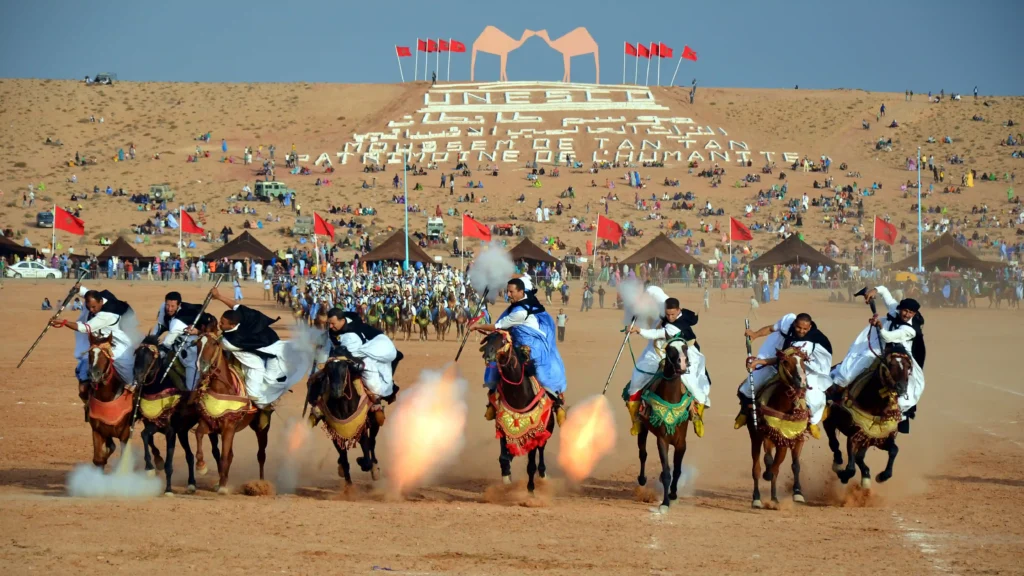
Modern Tbourida Morocco: Tradition Meets the 21st Century
Morocco’s Warrior Women: The Rise of Female Fantasia Troupes
One of the most exciting developments in contemporary Tbourida Morocco, has been the emergence of female riders who are challenging traditional gender roles while honoring ancient customs. Women’s troupes, once unthinkable in this traditionally masculine domain, now compete alongside their male counterparts in festivals across the kingdom.
These pioneering women face unique challenges, from sourcing traditional costumes that are suitable for female riders to overcoming societal skepticism about their place in this ancient art. However, their dedication and skill have gradually won over audiences and traditionalists alike. Many female riders bring fresh perspectives to Tbourida while maintaining deep respect for its cultural significance.
The success of women’s troupes reflects broader changes in Moroccan society, where traditional gender roles are evolving while cultural heritage remains paramount. These riders demonstrate that honor, courage, and horsemanship are not exclusively masculine virtues, opening new possibilities for future generations of Moroccan equestrians.
Fantasia as a Competitive Sport
Modern Tbourida Morocco has evolved beyond ceremonial displays to become a recognized competitive sport governed by the Moroccan Royal Federation of Equestrian Sports. National championships now attract hundreds of troupes from across the kingdom, competing for prestigious titles and substantial prize money.
Judging criteria have become increasingly sophisticated, evaluating performances based on formation precision, timing accuracy, costume authenticity, and the quality of the final rifle volley. Professional judges, often former riders themselves, score each troupe using standardized criteria that ensure fair competition while maintaining traditional standards.
This competitive structure has elevated the sport’s profile internationally, with Moroccan troupes now performing at equestrian events worldwide. The formalization has also helped preserve traditional techniques and costumes by establishing official standards and providing financial incentives for maintaining authenticity.
A Traveler’s Guide: How to Witness the Fantasia Festival in Person
Where and When to Go: Fantasia at the Moussem
A moussem is a traditional Moroccan festival that combines religious pilgrimage, commercial activity, and cultural celebration. These events, typically held annually in honor of local saints or during agricultural seasons, provide the most authentic settings for experiencing Tbourida Morocco performances.
Key Moussems and Festivals for Fantasia:
| Event | Location | Typical Timing | Special Features |
|---|---|---|---|
| Moussem of Moulay Abdallah | El Jadida | August | Beach setting with ocean backdrop |
| Festival of Roses | Kelaat M’Gouna | May | Mountain scenery, rose harvest celebration |
| Moussem of Sidi Ahmed ou Moussa | Tiznit | August | Traditional Berber culture emphasis |
| Cherry Festival | Sefrou | June | Atlas Mountains location |
| National Festival of Popular Arts | Marrakech | July | Multiple troupes, competitive atmosphere |
| Moussem of Tan-Tan | Tan-Tan | May-June | UNESCO-recognized cultural event |
The most spectacular performances typically occur during the summer months (June-September) when weather conditions favor outdoor gatherings and agricultural work slows. However, smaller moussems throughout the year offer more intimate experiences with local communities.
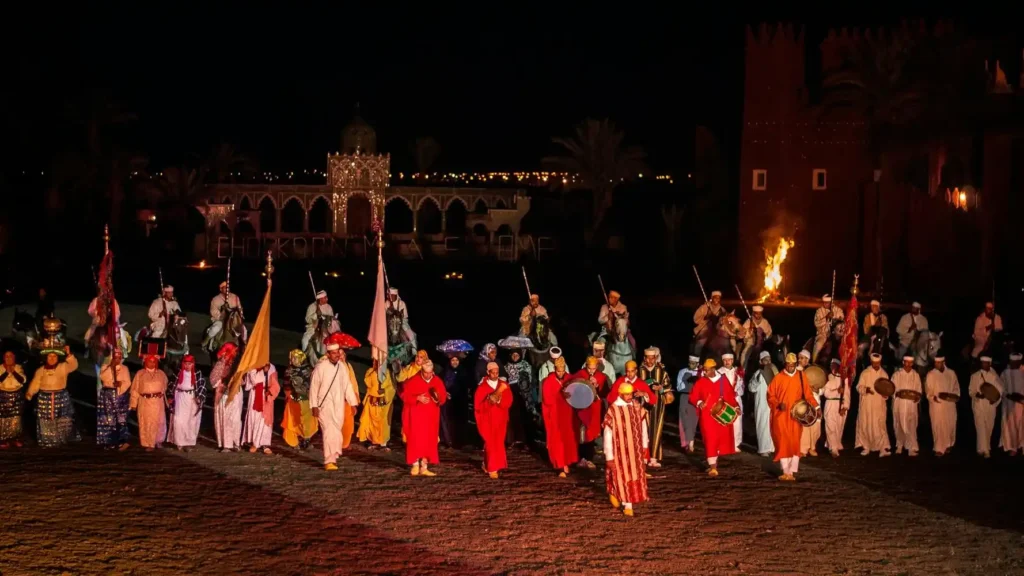
Tips for Spectators: Etiquette and Photography
Witnessing a Moroccan horse festival requires understanding proper etiquette and safety considerations:
Safety Guidelines:
- Maintain safe distances from the performance area, horses travel at high speeds, and rifles are fired
- Protect your hearing, especially children’s, as the gunfire can be extremely loud
- Stay alert during performances and follow local officials’ instructions
- Avoid sudden movements or loud noises that might spook the horses
Photography Etiquette:
- Always ask permission before photographing individual riders or their horses
- Respect restrictions on flash photography, which can startle animals
- Focus on capturing the spectacle rather than disrupting it
- Consider purchasing photos from local photographers who often have better access
Cultural Respect:
- Dress modestly, especially when visiting Moussem with religious components
- Learn basic Arabic greetings to show respect for local culture
- Observe quietly during ceremonial portions of events
- Support local vendors and artisans selling traditional crafts
Fantasia in Tours and Exhibitions
For travelers with limited time or those preferring structured experiences, several options exist for witnessing Tbourida performances:
Dinner Shows and Tourist Venues: Popular restaurants like Chez Ali in Marrakech offer staged Fantasia performances alongside traditional meals and entertainment. While less authentic than the Moussem festival Morocco performances, these shows provide convenient access to the spectacle with professional presentation and multilingual explanations.
Specialized Tour Operators: Companies like Desert Merzouga Tours can incorporate authentic Fantasia experiences into customized itineraries, combining cultural immersion with comfortable travel arrangements. These professional services handle logistics while ensuring access to genuine performances rather than tourist-oriented shows.
Private Arrangements: Experienced guides can arrange private Fantasia demonstrations with local troupes, offering intimate experiences and opportunities to interact with riders and their horses. These arrangements require planning but provide unparalleled authenticity and personal connection.
Frequently Asked Questions about the Moroccan Fantasia
What is the main goal of Fantasia? The primary objective is to demonstrate perfect synchronization between riders, horses, and the final rifle volley. Success is measured by the precision of the formation, timing of the charge, and unity of the gunfire—not by speed or individual showmanship.
Is Fantasia dangerous? While inherently involving risks due to high-speed horses and firearms, modern Tbourida emphasizes safety through extensive training, safety protocols, and experienced supervision. Serious injuries are rare when proper precautions are followed.
What kind of guns are used in Tbourida? Traditional moukahla rifles are used—ornate, single-shot firearms often centuries old and passed down through families. These weapons fire blank charges (gunpowder without projectiles) and are valued more for their historical and artistic significance than their functionality.
How much does it cost to see a Fantasia show? Costs vary dramatically depending on the setting. Authentic moussem performances are typically free, though donations are appreciated. Tourist dinner shows range from $30-100 per person, while private arrangements can cost $200-500, depending on group size and specificity.
What is the Moroccan Fantasia? It’s a traditional equestrian performance combining skilled horsemanship, ceremonial dress, and synchronized rifle fire to recreate historical cavalry charges, serving as both cultural preservation and entertainment.
What is the difference between Fantasia and Tbourida? “Fantasia” is the European name for this traditional art, while “Tbourida” is the proper Arabic term used by Moroccans. Both refer to the same cultural practice, but using “Tbourida” demonstrates cultural awareness and respect.
Where does the Fantasia festival take place? Tbourida performances occur throughout Morocco at traditional moussems, cultural festivals, tourist venues, and private events. The most authentic experiences are found at seasonal moussems in rural areas and smaller cities.
What is the history of Tbourida? The practice originated over 1,000 years ago as military training for Berber and Arab cavalry, evolving from practical warfare techniques into ceremonial displays that preserve Morocco’s martial heritage and cultural identity.
Are there female Fantasia riders? Yes, women’s troupes have emerged in recent decades, challenging traditional gender roles while maintaining respect for cultural customs. These pioneering female riders compete alongside male troupes and have gained acceptance within the Tbourida community.
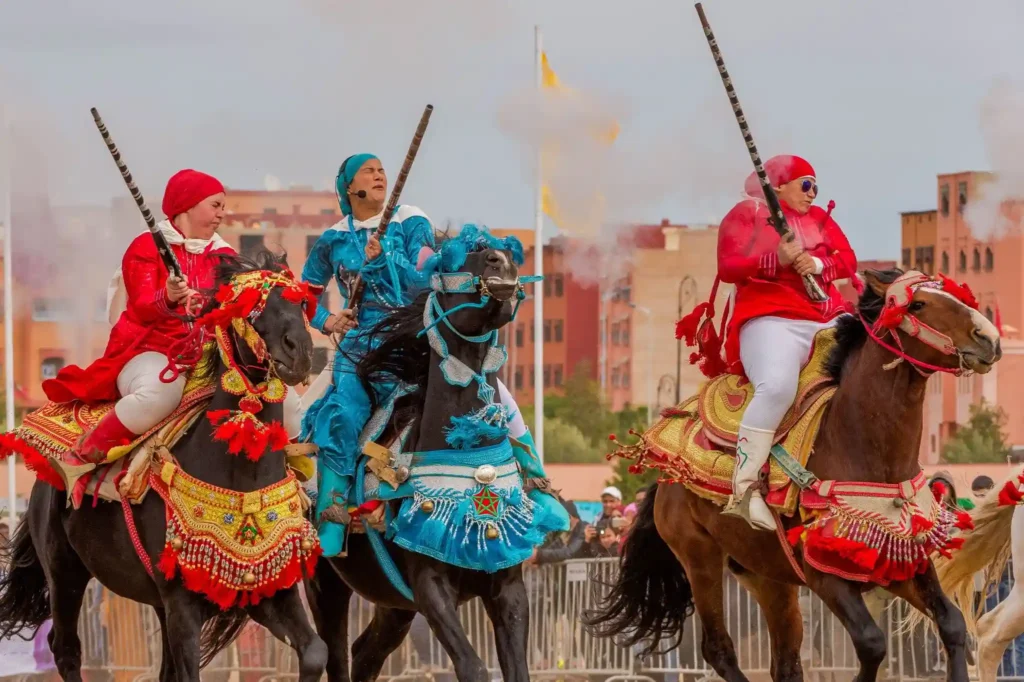
The Enduring Legacy of Fantasia
The Moroccan Fantasia Festival transcends simple entertainment to embody the very soul of Moroccan identity. In every thunderous charge and synchronized rifle volley, we witness the preservation of ancient traditions that connect modern Morocco to its warrior ancestors. This magnificent spectacle represents far more than skilled horsemanship; it’s a living museum of courage, honor, and cultural pride that has survived centuries of change while adapting to contemporary realities.
For the discerning traveler seeking authentic cultural experiences, Tbourida Morocco offers an unparalleled window into Morocco’s rich heritage. The ceremony demands respect for tradition while celebrating the evolution of Moroccan society, where women now ride alongside men and ancient arts find new expressions in competitive sport. Every performance carries forward the memories of countless generations, ensuring that future visitors will continue to experience this breathtaking tradition.
The enduring appeal of the Moroccan horse festival lies in its ability to transport spectators across centuries with a single thunderous volley. In our increasingly digital world, there’s something profoundly moving about witnessing skills passed down through generations, preserved not in museums but in the living practice of dedicated riders who carry forward their ancestors’ legacy.
Ready to Experience Morocco’s Fantasia Festival?
Are you planning a journey to Morocco and dreaming of witnessing the spectacular Tbourida Morocco performances firsthand? Let Desert Merzouga Tours help you incorporate an authentic Fantasia experience into your personalized itinerary. Our expert guides and cultural connections ensure you’ll witness genuine performances while enjoying the comfort and convenience of professional travel planning. From exclusive moussem access to private demonstrations, we’ll create unforgettable memories that capture the true spirit of Moroccan heritage.
Contact us today to begin planning your Moroccan adventure, where ancient traditions come alive in the thunder of hooves and the flash of gunpowder!

